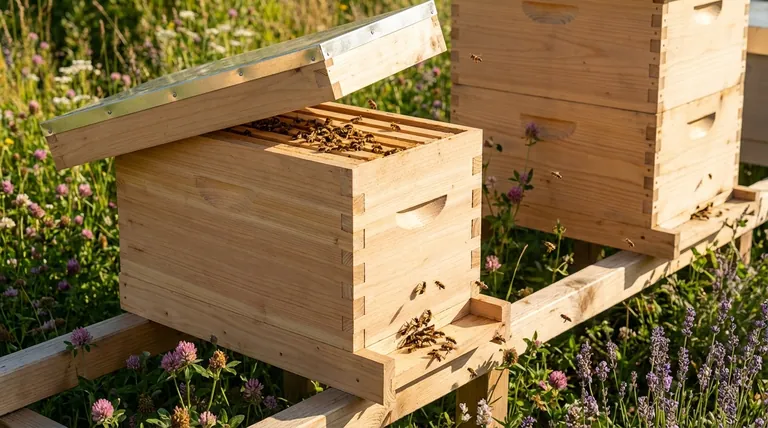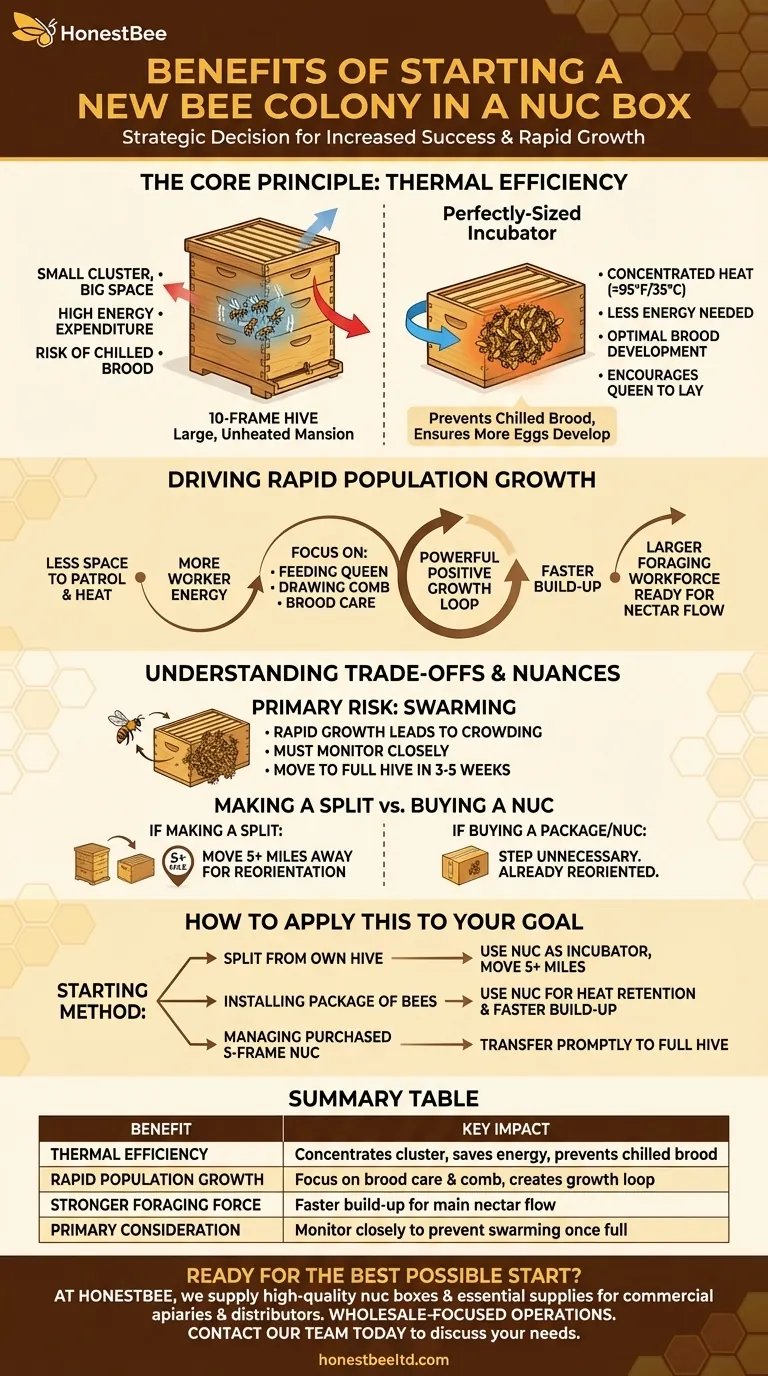Starting a new bee colony in a nuc box is a strategic decision that significantly increases its chances of success. Rather than placing a small population of bees in a large, empty hive, using a smaller nucleus (nuc) box for the first several weeks creates a controlled environment that concentrates the colony's energy, conserves heat, and accelerates brood production.
A full-sized hive is like a large, unheated mansion for a small new family of bees. A nuc box acts as a perfectly-sized incubator, allowing the colony to focus its resources on its most critical task: rapid population growth.

The Core Principle: Thermal Efficiency
The single greatest challenge for a new, small colony is regulating temperature, especially during the cool nights of spring.
Why a Full-Sized Hive is Too Big
A small cluster of bees in a large, 10-frame hive box must expend enormous amounts of energy to keep their queen and developing brood warm.
This often results in a very tight, small cluster. The bees are forced to prioritize heat generation over other essential tasks.
How a Nuc Box Solves the Problem
A nuc box is typically a 5-frame box, half the size of a standard hive body. This smaller volume requires far less energy to heat.
By confining the bees to this smaller space for the first few weeks, you create a warm, stable microclimate. The colony can maintain its ideal brood nest temperature (around 95°F or 35°C) with much less effort.
The Impact on the Queen and Brood
This thermal efficiency directly benefits the queen. In a warmer, more stable environment, she is encouraged to lay eggs across a larger area of the comb.
Most importantly, it prevents chilled brood. In a large box, brood on the outer edges of the cluster can get too cold during the night and die. A nuc box minimizes this loss, ensuring more of the queen's eggs develop into adult bees.
Driving Rapid Population Growth
A colony's success is measured by its ability to build its population quickly enough to take advantage of the season's main nectar flow.
Focusing the Colony's Energy
With less space to patrol and heat, the worker bees can dedicate their efforts to more productive tasks.
They can focus on feeding the queen, drawing out new comb, and caring for the rapidly expanding population of larvae. This creates a powerful positive feedback loop of growth.
A Stronger Start Before the Nectar Flow
A colony started in a nuc will almost always build up faster than one started in a full-sized hive.
This means your colony will have a larger foraging workforce ready to go when the primary nectar sources in your area begin to bloom, setting them up for a more productive first season.
Understanding the Trade-offs and Nuances
While highly effective, this method requires careful management and an understanding of the context.
The Primary Risk: Swarming
The benefit of a nuc box—its small size—is also its main liability. Because the colony grows so rapidly, it can quickly run out of space.
A colony that feels crowded is highly likely to swarm. You must monitor the nuc closely and be prepared to move the frames and bees into a full-sized hive as soon as they occupy all five frames, which often happens within 3-5 weeks.
Making a Split vs. Buying a Nuc
The advice to move a nuc 5+ miles away for several days is critical only if you are making a "split"—creating a new colony with frames of bees from a donor hive in the same apiary. This move resets the older foraging bees' orientation so they don't fly back to their original hive.
If you have purchased a package of bees or a ready-made nuc from a supplier, this step is unnecessary. The bees are already far from their original home and will orient to their new location.
How to Apply This to Your Goal
Your approach depends on how you are starting your new colony.
- If your primary focus is making a split from your own hive: Use a nuc box as an incubator for the new colony and be sure to move it at least five miles away for several days to ensure the bees reorient.
- If your primary focus is installing a package of bees: Starting them in a nuc box instead of a full-sized hive provides the same powerful heat-retention benefits and helps them build their population much faster.
- If your primary focus is managing a purchased 5-frame nuc: Your goal is to transfer it into a full-sized hive promptly. The nuc has served its purpose, and giving the bees room to expand is now the top priority.
By managing space effectively, you give your new colony the single greatest advantage for a successful first season.
Summary Table:
| Benefit | Key Impact |
|---|---|
| Thermal Efficiency | Concentrates bee cluster, reduces energy spent on heating, prevents chilled brood. |
| Rapid Population Growth | Allows bees to focus on brood care and comb building, creating a positive growth loop. |
| Stronger Foraging Force | Faster build-up ensures a larger workforce is ready for the main nectar flow. |
| Primary Consideration | Colony must be monitored closely to prevent swarming once the nuc box is full. |
Ready to give your new colonies the best possible start?
At HONESTBEE, we supply commercial apiaries and beekeeping equipment distributors with the high-quality nuc boxes and essential supplies needed to implement this successful strategy. Our wholesale-focused operations are designed to support your growth and efficiency.
Contact our team today to discuss your needs and discover how HONESTBEE can be your trusted partner in beekeeping success.
Visual Guide

Related Products
- 5 Frame Wooden Nuc Box for Beekeeping
- Twin Queen Styrofoam Honey Bee Nucs Mating and Breeding Box
- Automatic Heat Preservation 6 Frame Pro Nuc Box for Honey Bee Queen Mating
- Plastic Transporting Bee Packages and Nuc Boxes for Beekeeping
- Portable Bee Mating Hive Boxes Mini Mating Nucs 8 Frames for Queen Rearing
People Also Ask
- What is a common feature of many 5-frame nuc boxes? The Integrated Feeder for Efficient Colony Growth
- How should the nuc be installed in the apiary? Ensure Colony Success from Day One
- What are the benefits of moving nuclei around the apiary? Master Strategic Hive Management
- What is the purpose of having a nuc in beekeeping? Build a Resilient & Productive Apiary
- What frames should be moved into the queenless hive when requeening with a nuc? Ensure a Successful Queen Introduction



















